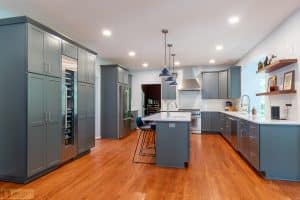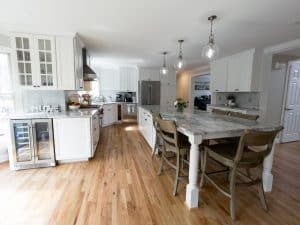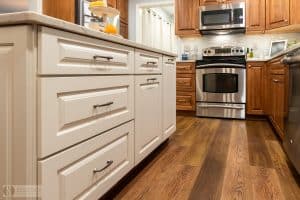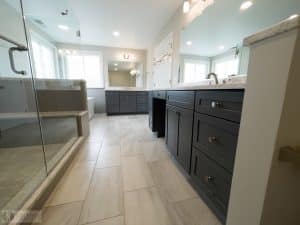Modern flooring has so many options to choose from. How do you know which one will suit your kitchen or bath design? Work out your flooring budget, allowing for extra labor costs if it’s a difficult material to cut or lay. It’s important to take into account where it will be laid and how much wear and tear it will have to endure. Will it need to withstand pet claws or be slip-resistant? Could it fade if placed near a bright window?
Then consider colors, patterns, and finishes that would suit the style of your remodel. Don’t dismiss certain materials on the basis of reputation or previous experiences. Technology has taken many classic but previously problematic flooring materials to a high-performance standard. At Solstice Kitchen and Bath, we can advise you on the perfect blend of form and function to floor your remodel for years to come.

Here are some of the flooring choices used for kitchen and bath designs in 2022.
What Are the Advantages of Solid Hardwood?
Solid hardwood is an elegant choice that is warm aesthetically and underfoot. It is durable and lasts a long time but has the added advantage that it can be changed up by altering its finish multiple times. Hand-scraping gives the surface more traction as well as bringing character to a design. Reclaimed wood is also ideal for introducing character, while the latest hardwood planks are often wider and longer and so have fewer seams.
There are many shades available in hardwood flooring. Varying tones throughout your flooring planks is a chic look, especially in a herringbone pattern. Lighter shades of wood are another popular choice, but the option is there to put a darker stain on them in the future. Oak, maple, and whitewashed wood are also stylish solutions that brighten up any bath or kitchen design.

What Are Its Disadvantages?
Solid hardwood is one of the most expensive types of flooring. It can also scratch easily, so consider it carefully if you have pets, kids, or freestanding furniture. There is a certain amount of planning that goes into laying hardwood as it is a natural material. It should be handled with care and left to acclimatize to its surroundings for several days. Once it has settled, it must be nailed or glued onto a subfloor, which increases installation costs. Hardwood floors are not ideal in moisture prone rooms. It can expand and contract and become slippery when wet. Bear this in mind in a kitchen design and, in general, avoid hardwood in a bathroom design.
What Are the Advantages of Engineered Hardwood?
Engineered hardwood is sustainably comprised of a layer of plywood or fiberboard that is topped with solid wood. The result is that it looks like solid hardwood flooring and can be stained or re-finished like hardwood (though less often than solid hardwood). It is less expensive than solid hardwood flooring and has the great advantage of not warping. This is especially good when laying extra-wide planks and means you don’t have to leave it to adjust to the room’s temperature before laying this type of flooring. Nails or glue are not required as engineered hardwood planks can be clicked together and float on top of a subfloor that’s not completely level.
What Are Its Disadvantages?
As it has a solid hardwood surface, engineered hardwood can also scratch and mark, but it can’t be refinished as often as hardwood. It’s not completely waterproof either so is also not suited to a busy bathroom design. It is durable, but due to its layering, won’t last as long as its solid wood counterpart.
What Are the Advantages of Laminate?
Laminate is a good choice for kitchen and bathroom flooring as you get the appearance of other materials that might not function as well for the demands of your busy home. Modern technology means there are vast improvements in laminate flooring, including more waterproof options. It can also come in distressed finishes, making it less slippery when wet. It is a sustainable choice, having a core of wood by-products. This core is covered with an image of another material, such as wood or stone, and then protected with a final, transparent layer. Laminate trends are as up to date as its counterparts, so you can get wide-plank patterns in varied tones if that is your preferred style. It’s easy to lay as it goes on top of a cushioned underlay and is more budget-friendly than the materials it mimics. Laminate flooring is warm, durable, and warp and scratch-resistant so is great for high traffic areas such as kitchens or bathrooms.
What Are Its Disadvantages?
While it looks the part, laminate will not feel like the genuine article, and it is not as long lasting as natural products. It also cannot be re-finished like hardwood surfaces. While this material is sustainable, check that your laminate flooring has low VOC (volatile organic substances) emissions.
What Are the Advantages of Vinyl?
Vinyl is an entirely synthetic material that also mimics a wide variety of surfaces. It has a core made from stone or wood-polymer and a protective layer over the image on top. It is completely waterproof so ideal for kitchen or bath designs. It comes in a single sheet that’s cut to size or as individual planks or tiles that can be clicked together or floated over the subfloor. The latest advances in Luxury Vinyl Tile (LVT) or Luxury Vinyl Plank (LVP) have the ability to create a surface that is durable, waterproof, and can closely mimic the natural material it is emulating. LVT and LVP are an ideal choice for a busy, moisture prone area like a bathroom design or a kitchen remodel but is stylish enough to use throughout your home to create a cohesive style with a single flooring material.

What Are the Disadvantages?
Vinyl can be an inexpensive option but the lower the price, the higher its VOC emission is likely to be. Lower priced vinyl is also less likely to last and will not look as good. For this reason, it is worth investing in a quality vinyl product like luxury vinyl to avoid damage to your health and the environment and have a surface that enhances your home’s style. There may also be hidden costs as your subfloor may need to be resurfaced to avoid lumps and bumps showing through the vinyl.
What Are the Advantages of Tiles?
Tile flooring is a classic and continually popular choice for kitchen and bath remodels, especially as it works well with underfloor heating. There are many materials to choose from, each resulting in a different look. There is a different shaped tile for every style of kitchen and bath design, and you can lay them in any formation you like.
Large-format tiles are very popular, and they also leave less grout to maintain. Ceramic tiles are made from baked clay and can mimic natural materials well, as well as being durable and waterproof. Natural stone tiles, such as marble or granite, are extremely durable and give a luxe feel to any bath or kitchen remodel. Cement tiles are increasingly popular. Their unique patterns bring character and individuality to a design along with the potential to be refinished. Porcelain tiles are more refined and, when glazed, they are waterproof and stain-repellent.

What Are the Disadvantages?
There is a lot of preparation, labor and maintenance involved in installing tile flooring. The subfloor must be prepared before the tiles are laid, and then they must be cut to size and then grouted when they are laid. Grout lines must also be maintained over time, and if your tiles need to be sealed this also should be done regularly. Porous materials such as natural stone and cement must be sealed to keep out moisture. Choose a textured surface for slippery tiles like glazed porcelain. If left unglazed, there is more traction and patina but there will eventually be water damage and stains.
What Are the Advantages of Concrete?
If the subfloor in your kitchen or bath remodel is concrete, then you can transform it into a stylish and functional floor for a cost-effective, durable choice. It takes some prepping to smooth it down and then you can stain it any color you like. It’s also possible to make it look like another flooring material such as natural stone or wood with intricately printed irregularities. You can also try a pattern similar to tiling or mosaics or add texture. If you want to keep it simple, then polishing it to enhance its natural color is always a good option, especially in a minimalist or industrial design.
What Are the Disadvantages?
Concrete floors tend to be slippery when wet. Adding texture to their finish might not be in your budget or design plans but is advised to avoid slipping. You might also need rugs or bathmats that you hadn’t planned for to make the floor feel safer. When your floor is finished, it’s vital that it is sealed properly by a professional. If it isn’t, it won’t be waterproof which could lead to ongoing problems in your kitchen or bath design.
Get Started!

There are advantages and disadvantages to every type of flooring. Assess what your needs are and what would suit your style. Talk to us at Solstice Kitchen and Bath and we can advise you on current trends and how to find the perfect balance between form and function. Contact us today and let your kitchen or bath remodel reach its full potential.
